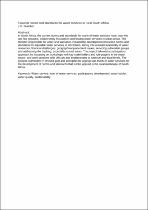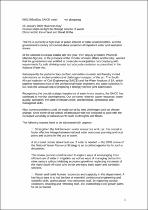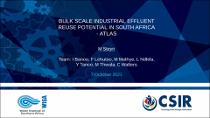 ResearchSpace
ResearchSpace
Spatial distribution of trace metals in water resources impacted by PGM activities
JavaScript is disabled for your browser. Some features of this site may not work without it.
- ResearchSpace
- →
- Research Publications/Outputs
- →
- Conference Publications
- →
- View Item
| dc.contributor.author |
Walters, Chavon R

|
|
| dc.contributor.author |
Somerset, V

|
|
| dc.contributor.author |
Van der Horst, C

|
|
| dc.contributor.author |
Silwana, B

|
|
| dc.contributor.author |
Le Roux, S

|
|
| dc.contributor.author |
Iwuoha, E

|
|
| dc.date.accessioned | 2013-04-18T06:49:20Z | |
| dc.date.available | 2013-04-18T06:49:20Z | |
| dc.date.issued | 2012-05 | |
| dc.identifier.citation | Walters, C.R., Somerset, V, Van der Horst, C, Silwana, B, Le Roux, S and Iwuoha, E. 2012. Spatial distribution of trace metals in water resources impacted by PGM activities. In: WISA Biennial Conference and Exhibition 2012, Cape Town International Conference Centre (CTICC), Cape Town, South Africa, 6-10 May 2012 | en_US |
| dc.identifier.uri | http://www.ewisa.co.za/literature/files/ID184%20Paper%20205%20Walters%20C.pdf | |
| dc.identifier.uri | http://hdl.handle.net/10204/6688 | |
| dc.description | WISA Biennial Conference and Exhibition 2012, Cape Town International Conference Centre (CTICC), Cape Town, South Africa, 6-10 May 2012. Published in EWISA 2012 Conference. | en_US |
| dc.description.abstract | Investigations of trace metal concentrations (Al, Fe, Cd, Pb, Zn and Hg) in surface water, surface sediment and fish in four of South Africa’s Water Management Areas (WMAs) were carried out in August (winter / dry) and November (summer / wet) 2010. The Limpopo, Luvuvhu-Lethaba, Crocodile (West) & Marico and Olifants WMAs are located in close proximity to PGM mining activities, and therefore any elevation in trace metal concentrations in environmental compartments would be of concern. Trace metals enter the aquatic environment from natural and anthropogenic sources (such as industrial effluents and mining wastes). Trace metals can accumulate in fish (which are often at the top of the aquatic food chain) either through water or the food chain (1), and metals bound to particulate matter in the water column may settle to bottom sediments (2). The objectives of the study were: (i) to establish the spatial variation in trace metal concentrations in water, sediment and biota of water resources in selected WMAs, (ii) to determine which environmental parameters most influence regional trace metal concentrations, and (iii) to assess the level and extent of contamination by comparison with recommended quality guidelines. In order to assess the extent of trace metal contamination in the each WMA, trace metals concentrations obtained were compared to the South African Water Quality Guidelines and other international guidelines. The distribution of trace metals did not vary drastically between sampling seasons. Aqueous concentrations of Al, Cd, Fe and Zn, generally measured less than 0.02, 0.005, 0.02 and 0.01, respectively. However, significant concentrations of Al, Fe, Pb and Zn were measured in sediment across most sites. Physiochemical water variables were regressed with the measured trace metal concentrations, however, no significant correlations were observed. Average metal concentrations in fish varied: Al 78.00, Cd 7.00, Fe 131.33, Pb 7.17 and Zn 127.8380 mg/kg, and were more strongly correlated to sediment metal concentrations and physiochemical variables than to aqueous metal concentrations. The results of this study indicated that related mining activities in the area had minimum impact on the aquatic environment in the vicinity. Although the rivers sampled in this study were not heavily polluted, periodical monitoring is recommended. | en_US |
| dc.language.iso | en | en_US |
| dc.publisher | WISA 2012 Conference | en_US |
| dc.relation.ispartofseries | Workflow;10388 | |
| dc.subject | South African water management | en_US |
| dc.subject | Water management areas | en_US |
| dc.subject | WMA | en_US |
| dc.subject | Water contamination | en_US |
| dc.subject | Water safety | en_US |
| dc.subject | Aquatic safety | en_US |
| dc.subject | South African river contamination | en_US |
| dc.subject | Metal contamination | en_US |
| dc.title | Spatial distribution of trace metals in water resources impacted by PGM activities | en_US |
| dc.type | Conference Presentation | en_US |
| dc.identifier.apacitation | Walters, C. R., Somerset, V., Van der Horst, C., Silwana, B., Le Roux, S., & Iwuoha, E. (2012). Spatial distribution of trace metals in water resources impacted by PGM activities. WISA 2012 Conference. http://hdl.handle.net/10204/6688 | en_ZA |
| dc.identifier.chicagocitation | Walters, Chavon R, V Somerset, C Van der Horst, B Silwana, S Le Roux, and E Iwuoha. "Spatial distribution of trace metals in water resources impacted by PGM activities." (2012): http://hdl.handle.net/10204/6688 | en_ZA |
| dc.identifier.vancouvercitation | Walters CR, Somerset V, Van der Horst C, Silwana B, Le Roux S, Iwuoha E, Spatial distribution of trace metals in water resources impacted by PGM activities; WISA 2012 Conference; 2012. http://hdl.handle.net/10204/6688 . | en_ZA |
| dc.identifier.ris | TY - Conference Presentation AU - Walters, Chavon R AU - Somerset, V AU - Van der Horst, C AU - Silwana, B AU - Le Roux, S AU - Iwuoha, E AB - Investigations of trace metal concentrations (Al, Fe, Cd, Pb, Zn and Hg) in surface water, surface sediment and fish in four of South Africa’s Water Management Areas (WMAs) were carried out in August (winter / dry) and November (summer / wet) 2010. The Limpopo, Luvuvhu-Lethaba, Crocodile (West) & Marico and Olifants WMAs are located in close proximity to PGM mining activities, and therefore any elevation in trace metal concentrations in environmental compartments would be of concern. Trace metals enter the aquatic environment from natural and anthropogenic sources (such as industrial effluents and mining wastes). Trace metals can accumulate in fish (which are often at the top of the aquatic food chain) either through water or the food chain (1), and metals bound to particulate matter in the water column may settle to bottom sediments (2). The objectives of the study were: (i) to establish the spatial variation in trace metal concentrations in water, sediment and biota of water resources in selected WMAs, (ii) to determine which environmental parameters most influence regional trace metal concentrations, and (iii) to assess the level and extent of contamination by comparison with recommended quality guidelines. In order to assess the extent of trace metal contamination in the each WMA, trace metals concentrations obtained were compared to the South African Water Quality Guidelines and other international guidelines. The distribution of trace metals did not vary drastically between sampling seasons. Aqueous concentrations of Al, Cd, Fe and Zn, generally measured less than 0.02, 0.005, 0.02 and 0.01, respectively. However, significant concentrations of Al, Fe, Pb and Zn were measured in sediment across most sites. Physiochemical water variables were regressed with the measured trace metal concentrations, however, no significant correlations were observed. Average metal concentrations in fish varied: Al 78.00, Cd 7.00, Fe 131.33, Pb 7.17 and Zn 127.8380 mg/kg, and were more strongly correlated to sediment metal concentrations and physiochemical variables than to aqueous metal concentrations. The results of this study indicated that related mining activities in the area had minimum impact on the aquatic environment in the vicinity. Although the rivers sampled in this study were not heavily polluted, periodical monitoring is recommended. DA - 2012-05 DB - ResearchSpace DP - CSIR KW - South African water management KW - Water management areas KW - WMA KW - Water contamination KW - Water safety KW - Aquatic safety KW - South African river contamination KW - Metal contamination LK - https://researchspace.csir.co.za PY - 2012 T1 - Spatial distribution of trace metals in water resources impacted by PGM activities TI - Spatial distribution of trace metals in water resources impacted by PGM activities UR - http://hdl.handle.net/10204/6688 ER - | en_ZA |








